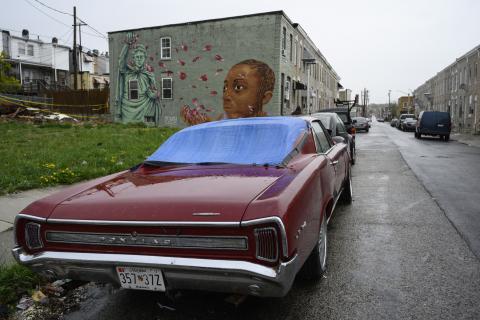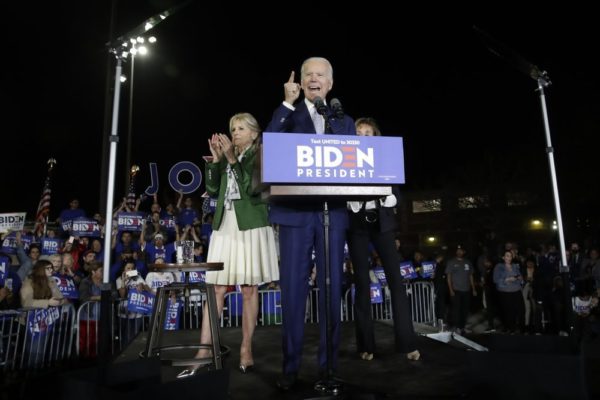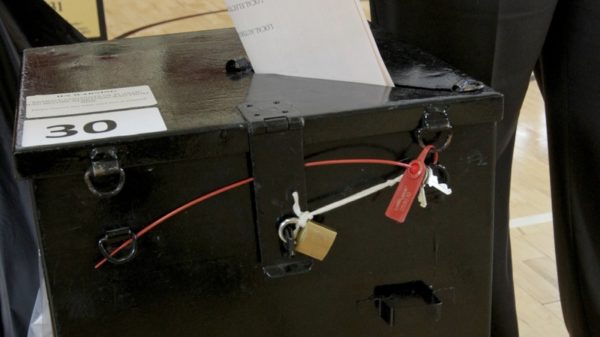Carl Stokes is a veteran of municipal politics in Baltimore, Maryland. When he decided – at almost the literal last minute – to run for city council president, he already knew the playbook for his campaign.
After all, Stokes has been running in Baltimore elections, on and off, since the 1980s.
“I’m a retail politician, a campaigner for real, and when I got into this race late I said I’d make it up quickly because I know how to hit every door,” says Stokes. “I know how to go to three, four community meetings a night. I go to churches, synagogues and mosques. That’s what I love.”
But Stokes, like everyone else, hadn’t planned on a pandemic. Now local candidates everywhere face an unusual question: How do you run for office when you can’t shake hands or knock on doors?
In local elections across the United States, candidates face a bizarre new world. Canvassing, rallies, and meet-and-greets are out. Direct mail may even be looked upon with suspicion. Hollowed out local media institutions struggle to cover these races in normal times, and now their few reporters are stretched even thinner. For candidates whose names don’t generate the kind of buzz seen in state-wide or national elections, the end of in-person campaigning is a severe blow to their ability to meet voters and raise money.
“Honestly, there’s no substitute for person-to-person, face-to-face contact in a small election,” says Mark Nevins, a political consultant with the Dover Group, who specialises in direct mail campaigns. “This has really changed the way campaigns are forced to find ways to communicate with voters – and not for the better.”
Many local candidates don’t have the luxury of waiting to see if the pandemic will wane by the fall. Most large US cities are governed by Democrats, meaning primary elections this spring and early summer are more competitive than November’s general election. American cities also can’t exercise the option pursued by their English counterparts, where this year’s mayoral elections are being postponed until 2021 in the hopes that things settle down by then.
No one knows what strategies will work best for this new kind of campaign, because nothing like this has happened before. Turnout fell following disasters like the Spanish Flu and Hurricane Sandy, but today’s pivot to mail-in voting complicates how predictive those experiences could be. Digital outreach operations could gain newfound significance, but runs the risk of reaching less-engaged younger voters and missing more reliable constituencies in unions and churches.
“This is going to be a whole new routine,” says Matthew Crenson, retired professor of political science at Johns Hopkins University, who believes Baltimore’s adoption of mail-in voting will boost participation. “What is that going to do to turnout overall, and to who turns out? It’s one of the big unknowns right now.”
Baltimore is representative of a certain subset of urban America, one of the many large but shrinking municipalities beset by decades of post-industrial woes. Over a fifth of the population lives in poverty, the median income is $11,400 lower than that of the United States overall, and the city has lost population every decade since the 1960s. Housing vacancy is over 19%, scarring many neighbourhoods, while the historic downtown is eerily quiet after 5:00 pm.
Baltimore also suffers from its own, highly specific traumas. The sheer number of annual murders substantially outpace those of New York, a city 13 times larger by population. Its last elected mayor resigned in disgrace after the Baltimore Sun implicated her in one of the most bizarre political scandals in recent memory.

(Eric Baradat/AFP via Getty Images)
Given Baltimore’s recent chain of demoralising governance failures and its long-standing economic issues – which local politicians have limited power to address – it would have been hard to get voters out no matter what. But that isn’t unique to Baltimore. Voter turnout in US municipal elections is often quite low and weighted towards certain demographic groups, usually older people and those with relatively higher incomes. A 2016 Portland State University study found that the median voter age in local US elections was 57.
“That’s always the challenge we have, making sure people actually come out to vote,” says Roxie Herbekian, president of Baltimore’s Unite Here Local 7, a union representing service workers in the hotel, entertainment and airport sectors. “The danger we always have is that working class and poor people aren’t going to vote. That’s why we take very seriously having our folks understand why the people we endorsed are the best candidates for workers.”
One of the roles of organisations like organised labour, churches, and the political machines of old is to connect those who are not economically powerful to the electoral system and to government institutions. But all of these entities have been in a state of decline for decades: in the private sector, unions like Unite Here represented only 6.2% of American workers in 2019.
Unlike other old industrial cities like Philadelphia or Chicago, Baltimore doesn’t have even the ghostly remnants of a political machine. It used to be home to a lively culture of “political clubs,” community establishments where residents came together to eat, drink, talk politics and get involved. They also served as neighbourhood-based machine organisations, but now they are largely defunct. Organised labour is still a power here, unlike in many Sunbelt cities, but overall union membership numbers are still substantially lower than they were in the 20th century.
Under normal circumstances, that could still give little-known candidates and low-cash insurgents an opportunity to fill the void. Candidates like Alexandria Ocasio-Cortez have won surprise victories without big money or institutional support by running energetic grassroots campaigns. But plague-era municipal politics are poorly suited to such an effort.
To some degree, that means that only the highest profile, or the wealthiest, candidates have a shot. In the Baltimore mayor’s race, that has allowed newcomers such as former Obama administration Treasury official Mary Miller to emerge as leading contenders. That’s because she can shovel $2 million of her own money into the race.
In the council president’s race, however, there is no one who can solely rely on self-funding. Still, the leading candidates – Stokes, Councilmember Shannon Sneed, and state representative Nick Mosby – are all well-established figures. All three say that the transition from in-person campaigning to digital and phone outreach has been difficult although, in many cases, they’ve found a surprisingly receptive audience. (A fourth council president candidate, councilmember Leon Pinkett, has not made a dent in the polls.)
Mosby is leading in the few pre-pandemic polls of the race and he says voters seem more engaged than ever, when he’s able to get in contact with them.
“That’s been a weird thing, because we know it’s a real delicate situation, talking to them about politics when they have all these other issues going on,” says Mosby. “But we’re not finding that folks are hesitant or disgruntled. They really just want to talk, maybe because they’re in the house and have more time.”
The three major council president candidates all plan to buy television ads, which are considered more essential than ever because viewership is surging during the pandemic. Although some television markets have seen declining costs for advertisements during the pandemic, Baltimore is not one of them. It costs $140,000 for a strong ad buy in the region, which means many candidates simply can’t afford them. So far only Sneed has spent seriously on the medium, with $60,000, while Stokes has spent $20,000 on television ads and Mosby has yet to spend anything (although he has plans to do so).
National political operatives like Zac McCrary say that the strength of TV ads may hold for most other forms of non-in-person outreach (except radio, because fewer people are commuting). He says his Democratic Party-aligned polling firm’s experiences across the US have mirrored Mosby’s reported successes on the phones in Baltimore.
“I suspect people are more likely to consume all these communication platforms – television, digital, mail – during this time when there’s limited options outside the house,” says McCrary, a partner with ALG Research. “We find that people are more willing to take phone interviews, more willing to take online polling options right now. They are maybe a touch more likely to read mail, as opposed to just throwing it away, because they are captive.”
The last prominent candidate in the council president race, Sneed, is known as a politician who hits the doors, an omnipresent figure at farmer’s markets and block parties. She is heavily backed by the city’s labour movement.
The question that haunts her is how turnout among her base, and among voters in general, will be affected by the presumed all-mail-in-primary.
“There may be a population that isn’t paying attention to [non-pandemic] news or isn’t in their normal social environment where elections may come up,” Sneed said. “I feel like maybe people won’t know to check their mailboxes because no one is talking about elections.”
Herbekian’s union has been calling members who are supporting their endorsed candidates, then checking to ensure they are registered and that all their information is correct on the Board of Elections website. They are also ensuring voters are clear on the steps needed to successfully vote-by-mail.
“We usually get together, someone brings food, and then we go knock on doors,” says Herbekian. “This is not quite as fun for everybody. But in some ways, it’s extremely efficient. Really, it’s much more efficient than us going around and talking to people one-by-one.”
For Stokes, the whole experience has been surreal. The 70-year-old has been trying to run his shoe leather campaign as best he can. One of the best strategies he’s come up with is giving out free food, which at least gives his campaign time to make a pitch and a good impression as they put groceries in the trunk of a voter’s car.
Stokes has also been giving out dinners and lunches to seniors, 150 to 200 of them a week. But he has to deliver the meals to the front desk of nursing homes for their staff to distribute.
“It’s uncomfortable in terms of campaigning,” says Stokes. “It just feels really weird and bad. I know some of the people who are in the building and I’d like to say hello to them. It feels very unusual [to just drive off]. But it is what it is.”
Jake Blumgart is a staff writer for CityMetric.
CORRECTION: The Sneed campaign originally provided an incorrect number for its television ad spending. That number has been corrected.


